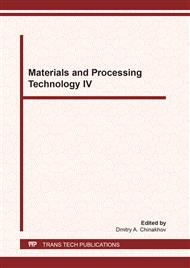[1]
Pelleg J. Mechanical properties of materials. – Dordrecht, Heidel- berg, New York, London: Springer, 2013. – 644 p.
Google Scholar
[2]
Gartsev S., Bernd Köhler B. Direct measurements of Rayleigh wave acoustoelastic constants for shot-peened superalloys // NDT & E Int. 2020. Vol. 113. P. 102279.
DOI: 10.1016/j.ndteint.2020.102279
Google Scholar
[3]
Lillamand I., Chaix J.-F., Ploix M.-A., Garnier V., Acoustoelastic effect in concrete material under uni-axial compressive loading // NDT & E Int. 2020. Vol. 43. Is. 8. P. 655-660.
DOI: 10.1016/j.ndteint.2010.07.001
Google Scholar
[4]
Murav'ev V.V., Volkova L.V. Estimation of residual stresses in locomotive wheel treads using the acoustoelasticity method // Rus. J. Nondestr. Test. 2013. Vol. 49. No. 7. P. 382 – 386.
DOI: 10.1134/s1061830913070073
Google Scholar
[5]
Chaki S., Bourse G. Guided ultrasonic waves for non-destructive monitoring of the stress levels in prestressed steel strands // Ultrasonics. 2009. Vol. 49. Is. 2. P. 162-171.
DOI: 10.1016/j.ultras.2008.07.009
Google Scholar
[6]
Murav'ev V.V., Murav'ev M.V., Bekher S.A. A novel technique of AE signal processing for upgrading the accuracy of flaw localization // Rus. J. Nondestr. Test. 2002. Vol. 38. No. 8. P. 600 – 610.
Google Scholar
[7]
Murav'ev V.V., Murav'eva O.V., Platunov A.V. et al. Investigations of acoustoelastic characteristics of rod waves in heat-treated steel wires using the electromagnetic-acoustic method // Rus. J. Nondestr. Test. 2012. Vol. 48. No. 8. P. 447 – 456.
DOI: 10.1134/s1061830912080062
Google Scholar
[8]
Toozandehjani M. et al. On the correlation between microstructural evolution and ultrasonic properties: a review // J. Mater. Sci. 2015. Vol. 50, № 7. P. 2643–2665.
Google Scholar
[9]
Takahashi S. Measurement of third-order elastic constants and stress dependent coefficients for steels // Mech. Adv. Mater. Mod. Process. 2018. Vol. 4, № 1.
DOI: 10.1186/s40759-018-0035-7
Google Scholar
[10]
Gebrekidan S.B. et al. Nonlinear ultrasonic characterization of early degradation of fatigued Al6061-T6 with harmonic generation technique // Ultrasonics. 2018. Vol. 85. P. 23–30.
DOI: 10.1016/j.ultras.2017.12.011
Google Scholar
[11]
Kumar A. Nonlinear ultrasonics for in situ damage detection during high frequency fatigue // J. Appl. Phys. 2009. Vol. 106. P. 024904.
Google Scholar
[12]
Valluri J.S., Balasubramaniam K., Prakash R.V. Creep damage characterization using non-linear ultrasonic techniques // Acta Mater. 2010. Vol. 58, № 6. P. 2079–(2090).
DOI: 10.1016/j.actamat.2009.11.050
Google Scholar
[13]
Cantrell J.H. Quantitative assessment of fatigue damage accumulation in wavy slip metals from acoustic harmonic generation // Phil. Mag. 2006. Vol. 86, № 11. P. 1539–1554.
DOI: 10.1080/14786430500365358
Google Scholar
[14]
Danilov V.I., Orlova D.V., Zuev L.B., Shlyakhova G.V. Special features of the localized plastic deformation and fracture of high chromium steel of the martensitic class // Rus. Phys. J. 2009. Vol. 52. No. 5. P. 525 – 531.
DOI: 10.1007/s11182-009-9258-8
Google Scholar
[15]
Shlyakhova G.V., Barannikova S.A., Zuev L.B. Nanostructure of superconducting Nb-Ti cable // Steel in Transl. 2013. Vol. 43. No. 10. P. 640 – 643.
DOI: 10.3103/s0967091213100124
Google Scholar
[16]
Shlyakhova G.V., Barannikova S.A., Bochkareva A.V., Li Y.V., Zuev L.B. Structure of a Carbon Steel–Stainless Steel Bimetal // Steel in Transl. 2018. V. 48 (4). P. 219-223.
DOI: 10.3103/s0967091218040101
Google Scholar
[17]
Barannikova S., Schlyakhova G., Maslova O., Li Y., Lev Z. Fine structural characterization of the elements of a Nb-Ti superconducting cable // J. Mater. Res. Tech. 2019. Vol. 8 (1). P. 323-332.
DOI: 10.1016/j.jmrt.2018.02.004
Google Scholar
[18]
Fierro G.P.M. et al. Nonlinear ultrasound modelling and validation of fatigue damage // J. Sound Vib. 2015. Vol. 343. P. 121–130.
Google Scholar
[19]
Kim J.-Y. et al. Acoustic Nonlinearity Parameter Due to Microplasticity // J. Nondestruct. Eval. 2006. Vol. 25, № 1. P. 28–36.
DOI: 10.1007/s10921-006-0004-7
Google Scholar
[20]
Guz A.N., Makhort, F.G. The physical fundamentals of the ultrasonic nondestructive stress analysis of solids // Int. Appl. Mech. 2000. Vol. 36 (9). P. 1119-1149.
Google Scholar
[21]
Khan S.Z. et al. Assessment of material properties of AISI 316L stainless steel using non-destructive testing // Nondestruct. Test. Eval. 2016. Vol. 31, № 4. P. 360–370.
DOI: 10.1080/10589759.2015.1121265
Google Scholar
[22]
Carreon H. et al. Relation between hardness and ultrasonic velocity on pipeline steel welded joints // Nondestruct. Test. Eval. 2016. Vol. 31. Is. 2. P. 97–108.
Google Scholar
[23]
Ohtani T. et al. Ultrasonic attenuation and microstructural evolution throughout tension–compression fatigue of a low-carbon steel // Mater. Sci. Eng. A. 2006. Vol. 442. Is. 1. P. 466–470.
DOI: 10.1016/j.msea.2006.02.226
Google Scholar


